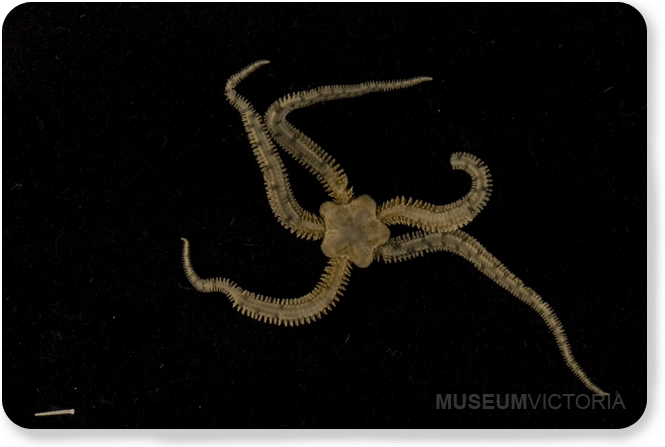
Home -> Species index -> Species description
 More images | Distribution map More images | Distribution map | F 94662. Family - Ophiactidae. |
Description The disc is flat, interradial edge petaloid (some petaloid), 8 mm diameter. The radial shields are triangular with rounded corners, separated and parallel to one another, with 1–3 plates between them; 2–2.5 times long as wide, and length 0.18 times d.d. The dorsal surface is covered by plates, bearing spines/granules, with a visible diameter of 0.1–0.4 mm, overlapping; primary plates not visible. Disc spines or granules of one type, cylindrical and pointed or conical, with multiple, more than 3, terminal points/thorns. The spines are up to 0.05–0.2 mm long, and 2–4 times high as wide; restricted to regions of the disc (edge of disc). The ventral interradial surface is with skin. The oral shields are covered in skin. The adoral shields are covered in skin. Bursal slits extend from the oral shield to the disc margin, not bordered by spines or papillae. The jaw is longer than wide or as wide as long, with one, rounded apical papilla (rippled distal edge), as wide as long or wider than long. Oral papillae separated by a gap from apical papillae, quadrangular (flat). The oral tentacle pore is located inside the jaw (out), with distal oral papilla enlarged, and triangular or quadrangular. The specimen has five arms, unbranched, moniliform, 5–7 times d.d. Multiple dorsal arm plates per segment (2 overlapping and laterally adjacent), contiguous, without spines/granules; quadrangular, and 0.35–0.5 times long as wide (together side by side). The second ventral arm plates are not visible, covered by skin. Ventral arm plates of the first free segments contiguous, oval, and 0.9–1.1 times long as wide. Tentacle pores along the arm, with one scale, covering the pore, oval. There are 1–2 arm spines on the first ventral segment, 4 on the first free segments. The spines are erect, extending laterally, subequal or longest in middle, and 1–2 times as long as one arm segment, blunt, flattened. There are thorns, on the tip.
Description exported from Delta key and to be finalised when DNA sampling completed. Note species description and image characters may vary slightly in animals of different size within the same species. Cite this publication as: "T O'Hara
(2010). ‘Ophiuroids from deep sea southern Australia. Museum Victoria. Version:
1.0 http://www.museumvictoria.com.au/stars" MUSEUMVICTORIA |